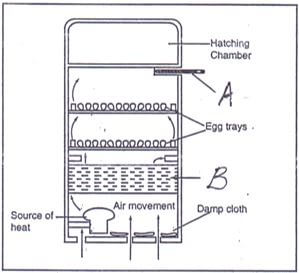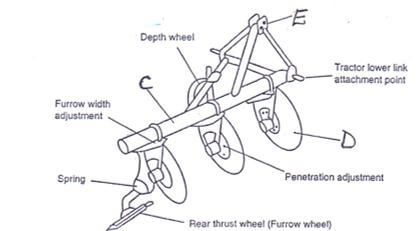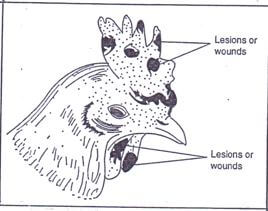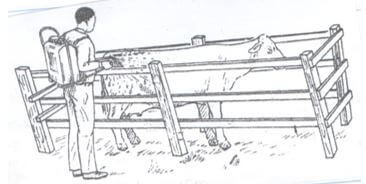INSTRUCTION TO CANDIDATES
- Write your name and index number in the spaces provided above.
- Sign and write the date of Examination in the space provided.
- This paper consists of three sections A, B and C.
- Answer ALL the questions in section A and B.
- Answer TWO questions in section C in the spaces provided.
FOR EXAMINER’S USE ONLY.
|
SECTION |
QUESTIONS |
MAXIMUM SCORE |
CANDIDATES SCORE |
|
A |
1 – 15 |
30 |
|
|
B |
16 – 19 |
20 |
|
|
C |
20– 22 |
20 20 |
|
|
TOTAL SCORE |
90 |
QUESTIONS
SECTION A (30MKS|)
Answer all questions in this section on spaces provided.
- State four non-chemical method used to control ticks (2marks)
- Highlight two management practices carried out on a broody hen (2marks)
- Give four characteristics of a good fish pond (2marks)
- Mention four physical characteristics of exotic beef cattle breeds (2marks)
- Give four features of calf pen that help to control calf diseases (2marks)
-
- What is dry cow therapy (1mark)
- At what stage of gestation is dry cow therapy practiced (1mark)
- Name four farm structures used for handling livestock (2marks)
- Give four symptoms of respiratory disorders in a sick cow (2marks)
- Mention two characteristics of abdomen of a poor layers (2marks)
- Distinguish between mothering ability and prolificacy (2marks)
- List two factors that can lead to conception failure after female cow has been served (2marks)
- Give four factors that may lead to a farmer culling dairy cattle (2marks)
- State four reasons for doing Agriculture as a discipline (2marks)
- Name four tools that are used when laying concrete blocks during construction of a wall (2marks)
- State four features on the animal which may pre-dispose it to livestock diseases (2marks)
SECTION B (20 MARKS)
Answer ALL questions in this section in the spaces provided
- The following is a diagram of an artificial incubator. Study it and answer questions that follow.

- Identify the following parts shown by letters A and B. (2marks)
A .
B . - State three conditions that are necessary for a successful hatching. (3marks)
- Identify the following parts shown by letters A and B. (2marks)
- Study the following farm implement and answer the questions below.

- Identify the above implement. (½mark)
- Identify the parts shown by letters C, D, E. (1½marks)
C ..
D ..
E .. - Give three reasons that make the implement better in land preparation. (3marks)
- Study the following diagram and answer questions below.

- Identify the above disease. (1mark)
- What causes the above disease? (1mark)
- Give two predisposing factors of the disease. (2marks)
- Give one control measure of the disease. (1mark)
- The illustration below shows a farm practice used in controlling external parasites in livestock. Study it and answer the questions that follows.

- Identify the methods of parasite control in the illustration above (1mark)
- Name the equipment used for the practice in the illustration (1mark)
- State two factors that leads to maximum effectiveness when using the practice above in tick control (2marks)
- Name any other equipment that is used for the same practice (1mark)
SECTION C (40 MARKS)
Answer any two questions from this section.
-
- Explain eight practices you can carry out in a crush. (8 marks)
- Describe six advantages of rotational grazing. (6 marks)
- Describe six effects of parasites on livestock. (6 marks)
-
- Describe eight short term services that should be done to a farm tractor. (8 marks)
- Explain five reasons for maintaining farm tools and equipment. (5marks)
- State eight causes of long calving intervals. (7marks)
-
- Describe ten uses of fences on a farm. (10 marks)
- Explain five factors a farmer should consider in the construction of farm structures. (10 marks)
MARKING SCHEME
- Non-chemical methods to control ticks
- Burn infested pasture
- Hand pick and kill
- Rotational grazing
- Double fencing
- Restrict animal movement (zero grazing) (4 x ½=2mks)
- Management practices on broody hen
- Provide drinking water adlip
- Provide balanced diet
- Dust with insecticide to control parasites
- Give hen chance to exercise ( 2 x 1=2mks)
- Characteristics of good fish pond
- Gentle slopping
- Reliable water source
- Area with no cracks/anthills
- Clay soil which is poorly drained
- Secure from predators /thieves
- Site should be accessible (4 x ½=2mks)
- Characteristics of beef breeds
- They are blocky
- They have strong short legs
- Bodies are well fleshed
- They have small udder
- They have thick neck ( 4 x ½=2mks)
- Calf pen to control diseases
- Well ventilated
- Well lit
- Easy to clean
- Free from draught
- Spacious
- Lack proof
- Well drained
-
- A dry cow theraphy – practice of applying mastitis antibiotic in teat canal in cow that is being dried off. (1mk)
- Dry cow theraphy done last 2 months of gestation (1mk)
- Structures to handle livestock
- Crush
- Calf pens
- Fences
- Milking shed
- Cattle shed (4 x ½=2mks)
- Respiratory disorder
- Difficult breathing
- Coughing
- Snoring
- Sneezing
- Running nose (4 x ½=2mks)
- Characteristics of poor layers
- Hard/stiff abdomen
- Full/well fleshed abdomen
- Small space between kneel and pelvic bone allow less than 2 fingers ( 2 x 1=2mks)
- Mothering ability is ability of mother to care for young ones while prolificacy is ability of mother to produce many young ones at once. (Mark as a whole)
( 2 x 1=2mks) - Factors leading to female cow fail to conceive
- Poor nutrition
- Poor timing of services
- Infertile cow/bull ( 2 x 1=2mks)
- Reason for culling dairy cattle
- Poor health
- Poor quality products
- Old age
- Wild temperament
- Low production (4 x ½=2mks)
- Reasons for doing Agriculture as a discipline
- Provide skills in Agriculture and practices
- It is a career subject
- Createself-employment and self-reliance in food
- Agriculture promote environmental conservation
- Agriculture promote cohesion in diverse culture
- Agriculture promote school to take part in Agricultural practices eg young farmers
(4 x ½=2mks)
- Tools use to lay concrete block
- Plumb bob/plumb line
- Mason’s trowel
- Spirit level
- Wood float (4 x ½=2mks)
- Factors pre-disposing animal to diseases
- Sex
- Colour
- Age
- Physiological conditions sickness/pregnancy/emaciation/lactating
- Physical injuries (4 x ½=2mks)
- The following is a diagram of an artificial incubator. Study it and answer questions that follow.
- Identify the following parts shown by letters A and B. (2 marks)
- A Thermometer
- B Warm water
- State three conditions that are necessary for a successful hatching. (3 marks)
- Temperature should be ideal preferably 37.5ºC – 39.4ºC to maintain a healthy growth of the embryo.
- Fresh air is ideal in the incubator for embryonic development
- A relative humidity of 60% is ideal in production of healthy chicks during hatching.
- Egg turning regularly is necessary to avoid the germinal disk sticking onto the egg shell that leads to embryonic mortality
- Identify the following parts shown by letters A and B. (2 marks)
- Study the following farm implement and answer the questions below
- Identify the above implement. ( ½ mark)
- Disc plough
- Identify the parts shown by letters C, D, E. (1 ½ marks)
- C Beam
- D Disc
- E Top link
- Give three reasons that make the implement better in land preparation. (3 marks)
- Can be used in a field with obstacles as it rolls over them.
- The implement is hardly and does not break easily hence requiring less maintenance.
- The implement requires less draught power due to the rotting effect of the disc.
- The implement is suitable for hard and we sticky soils especially those dominated by clay.
- Identify the above implement. ( ½ mark)
- Study the following diagram and answer questions below.
- Identify the above disease. (1 mark)
- Fowl pox
- What causes the above disease? (1 mark)
- Virus / Avian fox
- Give two predisposing factors of the disease. (2 marks)
- Wounds on the body
- Presence of mosquitoes, ticks, lice, and other biting insects.
- Give one control measure of the disease. (1 mark)
- Vaccinating all the healthy birds every 6 months
- Killing all the affected birds and disposing the carcasses properly
- Identify the above disease. (1 mark)
-
- Hand spraying (1x1=1mks)
- Knap sack sprayer (1x1=1mks)
-
- The sprayer should be in good working conditions
- Use the recommended chemical concentration
- Complete wetting of the animal
- Animal should be property restrained (First 2x1 = 2mks)
- Strip/bucket pump. (1x1 = 1)
-
- Explain eight functions you can carry out in a crush. (8 marks)
- Spraying livestock against external parasites
- Identifying the livestock by branding, ear tagging, ear notching
- Vaccination against notifiable diseases
- Administering prophylactic drugs to livestock in control of diseases
- Treating livestock with other medicants like antihelminths.
- Dehorning livestock to avoid risks of horns.
- Pregnancy, testing in identification of fertility.
- Artificial insemination in avoidance of natural mating.
- Taking body temperature in checking for fever.
- Hoof trimming to avoid foot rot.
- Milking the cows twice a day.
- Describe six advantages of rotational grazing. (6 marks)
- Maximum use of the pasture is made by livestock.
- Buildup of pests and diseases is reduced
- Animals faecal material is distributed evenly in all paddocks,
- Pastures are given time to regrow before grazing is done again.
- Excess pastures can be harvested and conserved.
- Fertilizers reseeding and weeding can be done on pastures that are not in use.
- Describe six effects of parasites on livestock. (6 marks)
- Suck large volumes of blood causing anaemia in livestock.
- Deprive the host livestock food by extracting nutrients from the alimentary canal of the host animal.
- Injury and damage to tissues and organs mainly the skin and internal organs damaged during migration causing haemorrhage.
- The wounds created on the hides and skins are entry points of disease pathogens and infection.
- Many parasites are vectors of infectious diseases spreading them to other livestock.
- When parasites bite the livestock on their hides and skins they create irritation.
- Obstruction of internal organs mainly the small intestines occurs when internal parasites accumulate causing constipation.
- Explain eight functions you can carry out in a crush. (8 marks)
-
- Describe eight short term services that should be done to a farm tractor.(8 marks)
- Engine oil should be checked daily by use of a dip stick and added if the level is low.
- The fuel should also be checked if low added.
- Water level should also be checked in the radiator and topped up.
- The electrolyte in the battery should be checked and topped up if below the plates.
- Bolts and nuts should be tightened daily.
- Greasing the nipples of the tractor is necessary.
- Sediments should be removed from the sedimentary bowl.
- Tyre pressure should be checked in the tyres and adjusted every day.
- The fan belt tension should be checked so that it can charge the battery by running the generator.
- Brake shaft bearing should be greased.
- Explain five reasons for maintaining farm tools and equipment. (5 marks)
- Increase the durability of tools and equipment to last long.
- To reduce the replacement cost hence save on spending excessively.
- Increase efficiency so that work can be down with comfort without stress.
- Avoid injuries to the user that is done by blunt tools or those with poor handles.
- Avoid damage to the tools that may include breakages to the tools if poorly maintained.
- Causes of long calving intervals
- Poor health
- Poor nutrition
- Poor selection
- Incorrect time of service
- Irregular heat signs
- High milk production
- Type of breed
- Poor breeding methods
- Describe eight short term services that should be done to a farm tractor.(8 marks)
-
- Describe ten uses of fences on a farm. (10 marks)
- Provide security from thieves, wildlife, trespassers.
- Enable paddocking/rotational grazing/mixed farming
- Control parasites and diseases by keeping away neighbouring animals
- Demarcating the boundaries.
- Live, fences act as windbreakers and shelter belts.
- Provide aesthetic value to the farm
- Increase the farm land value
- Help in soil and water conservation in case of hedges
- Hedges may be a source of fruits and their trimmings a source of fodder, firewood, compost manure.
- Provide privacy
- Isolation of animals for different purposes like treatment, gestation, bull isolation.
- Explain ten factors a farmer should consider in the construction of farm structures. (10*1marks)
- Sitting in relation to other buildings farm activities, security, accessibility, drainage.
- Orientation in relation to the prevailing wind direction and sunlight.
- Purpose and design is usually for the purpose intended considering the climate and size of the enterprise.
- Materials should account for the cost, availability, durability.
- Capital will depend on the cost of the structure and finances available.
- Flexibility by alternative uses of the structure.
- Required skill considering the skill required and that available on the farm.
- Government regulations have to be followed.
- Type of the building is also considered whether permanent or temporary.
- Future expansion is also considered while constructing.
- Describe ten uses of fences on a farm. (10 marks)
Download Agriculture Paper 2 Questions and Answers - Londiani Joint Mock Exams 2022.
Tap Here to Download for 50/-
Get on WhatsApp for 50/-
Why download?
- ✔ To read offline at any time.
- ✔ To Print at your convenience
- ✔ Share Easily with Friends / Students
